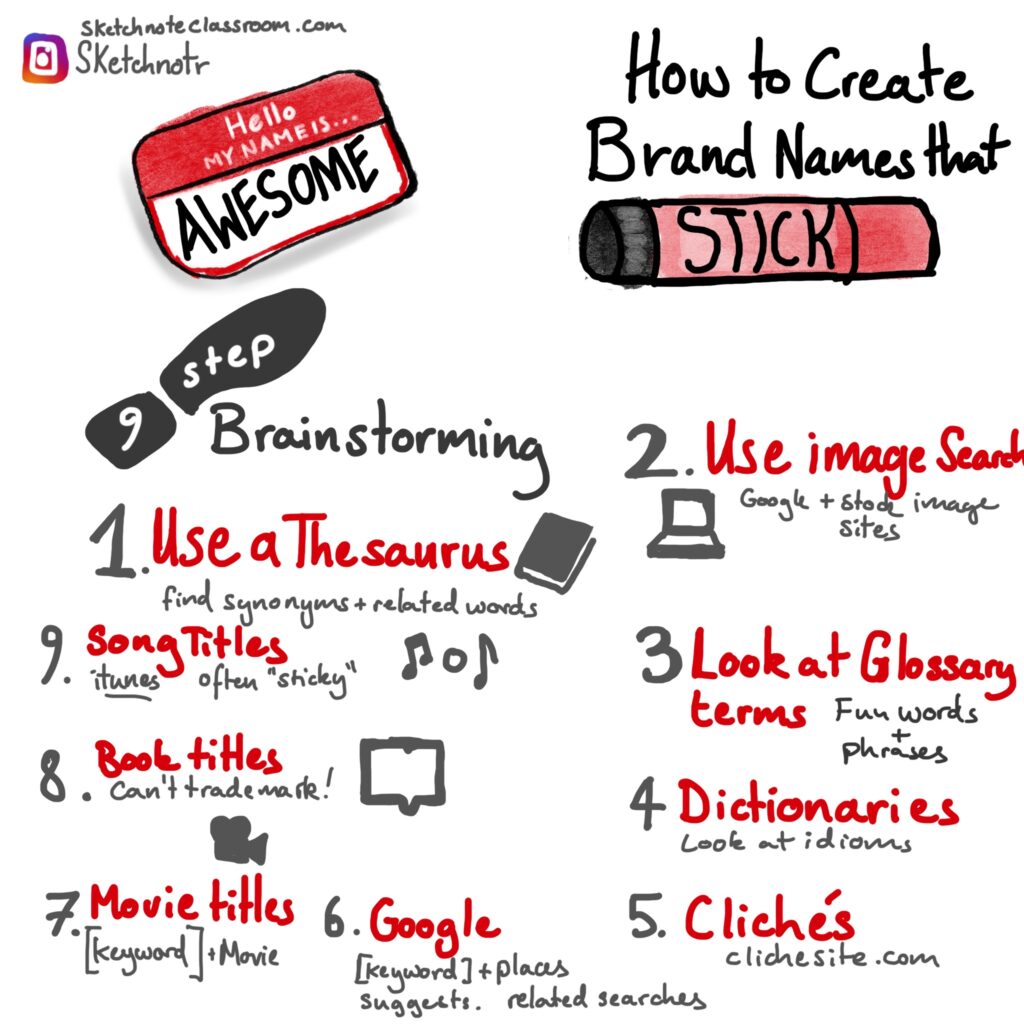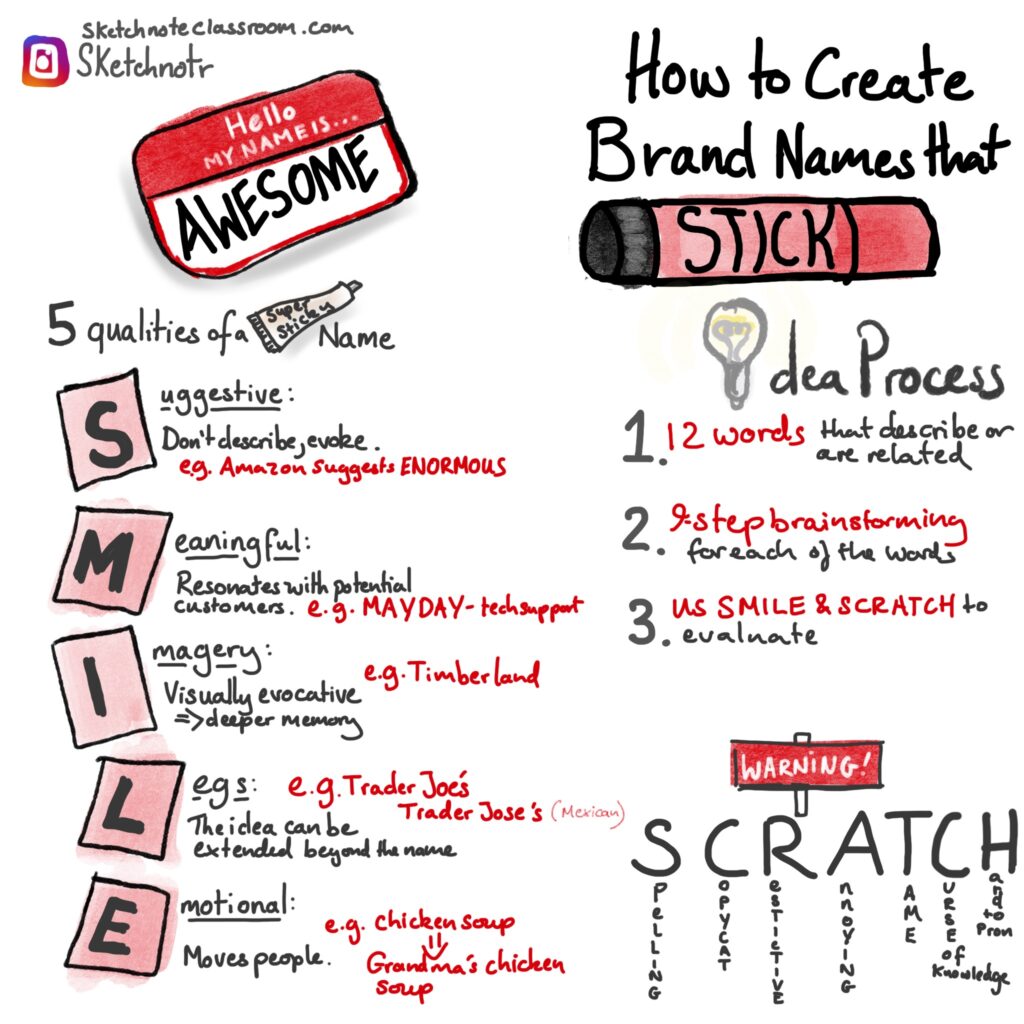I’ve taken part in a few brand naming exercises over the last couple of years. Most of these were for products but the need for a good name was the same. While it’s easy to spot a good name in the wild, coming up with one is another matter.
For years I had just assume that it was a matter of luck, thinking and waiting, but the action plan in the book Hello, my name is awesome makes this process more straight forward, even if it does still require a lot of time, energy and thought to come up with a good name.
This books summary has my main takeaways and will provide you with a guideline that you can implement as well.
How to create brand names that stick Actions steps to come up with a brand name
There are really four steps to generate a brand or product name.
- Generate 12 words that describe or are related to your brand.
- Follow a nine step brainstorming (or expansion) of these words
- Synthesize your research into name ideas
- Use the SMILE and SCRATCH criteria to review the possible names you have
Why this process works
This process is based on the same mindset as that in “A Technique for Producing Ideas” by James Webb Young.
You immerse yourself in a topic till you gain mind fog, you distract your mind from the task and let your subconscious chew on it, you wait for eureka and then refine the idea from there.
The process in Hello, My Name Is Awesome just helps you drown yourself in the topic of a product name.
The additional aspect I recommend from “A Technique for Producing Ideas” is to engage in an emotionally stimulating distraction when you feel overwhelmed by a topic.
The list of 12
To start, you need a list of 12 words that describe or are related to the brand. Look for a diverse list and avoid just stating synonyms; that will come later.
The brainstorming process

The brainstorming process is about turning that list of 12 into a list of 1200!
You want to dive into a wide variety of different stimuli to find alternative ways of saying a word or how others have used the name in the past.
The nine steps are
- Using a thesaurus for synonyms
- Using image search to see visual associations
- Using a Glossary to find related industry words
- Using Dictionaries to see idioms and expressions
- Using Clichesite.com to find Cliche’s related to the term
- Using Google suggestions and related searches
- Using movie titles
- Using book titles
- Using song titles
Book titles are particularly useful as they aren’t subject to copyright and so can be reused.
Once you have completed this process for every word, you will have a long list of ideas and inspiration to draw upon. You may be starting to feel mental and topical fatigue. That’s a good sign that you have fill your brain with the topic.
Synthesis
The key part of synthesizing an idea is subconscious, but you should still start by consciously trying combinations of words and name ideas. You may find THE idea this way, but even if you do, let your subconscious have a go at crunching all the information you’ve filled it with and see if it can generate a better idea.
Deliberately give your brain a break when you can’t think any more, but keep a note book with you. This break could be a shower, a long walk, a good film or a trip to an art gallery. relaxing and emotionally stimulating tasks work best.
Once you’ve got a few idea down, it’s time to evaluate.
The review process: Smile and scratch

You’re review process has two steps.
- Smile – finding good names.
- Scratch – eliminating bad ones.
SMILE: 5 Qualities of sticky names
- Suggestive – It doesn’t describe, it evokes.
- Meaningful – Something that will resonate with potential customers
- Imagery – Something which is visually evocative
- Legs – An idea which can be extended
- Emotional – Something which moves people, reminds them of memories and associations.
SCRATCH: Ideas to remove
- Spelling – don’t use clever spellings, it confuses people
- Copycat – don’t follow other companies, be original
- Restrictive – It doesn’t allow for future growth
- Annoying – Something that is forced or just doesn’t work.
- Tame – Don’t go for a safe, boring and forgettable name
- Curse of Knowledge – Don’t use a name that only makes sense to you and your inner group
- Hard to pronounce – Make sure people can tell others what your name is
Finding the domain
Once you’ve gone through all this process, then you should look at domain names and usernames on social media platforms. This might seem like it’s too later and it might but the copycat step should help eliminate some problems by this point. If you find there’s another company with the same domain (and there’s a good chance of that now), you can either use a more unique TLD or add a verb to the start of your website domain, like getflywheel.com which offers domain hosting.
Grab a copy of Hello, My Name Is Awesome
If you’d like to read the whole, short book, grab a copy bellow.
Or you can check out other book summaries here.

Leave a Reply